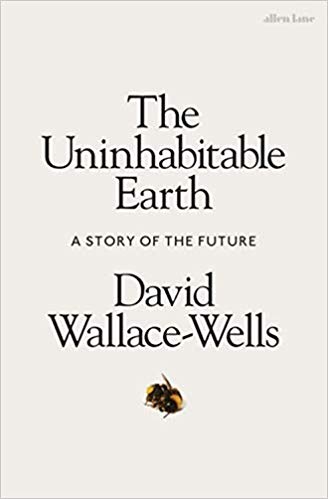The Uninhabitable Earth
A Story Of The Future
David Wallace Wells

Concise, powerful. The kind of book that shifts public discourse.
That is the course we are speeding so blithely along — to more than four degrees Celsius of warming by the year 2100.
Those more panicked are often hardly less complacent, living instead through climate fatalism as though it were climate optimism.
We found a way to engineer devastation, and we can find a way to engineer our way out of it— or, rather, engineer our way toward a degraded muddle, but one that nevertheless extends forward the promise of new generations finding their own way forward, perhaps toward some brighter environmental future.
Warming of 3 or 3.5 degrees would unleash suffering beyond anything that humans have ever experienced through many millennia of strain and strife and all- out war. But it is not a fatalistic scenario; in fact, it’s a whole lot better than where we are headed.
I think you have to do everything you can to make the world accommodate dignified and flourishing life, rather than giving up early, before the fight has been lost or won, and acclimating yourself to a dreary future brought into being by others less concerned about climate pain. The
“the impacts of climate change will be channeled primarily through the water cycle.”
With CO2 at 930 parts per million (more than double where we are today), cognitive ability declines by 21 percent.
Globally, one out of six deaths is caused by air pollution.
In 2018, the World Bank estimated that the current path of carbon emissions would sharply diminish the living conditions of 800 million living throughout South Asia. 9 One hundred million, they say, will be dragged into extreme poverty by climate change just over the next decade.
Should the planet warm 3.7 degrees, one assessment suggests, climate change damages could total $ 551 trillion— nearly twice as much wealth as exists in the world today. We are on track for more warming still.
In its swaggering twentieth century, the United States built two states of paradise: Florida, out of dismal swamp, and Southern California, out of desert. By 2100, neither will endure as Edenic postcards.
There is also the ambiguity effect, which suggests that most people are so uncomfortable contemplating uncertainty, they will accept lesser outcomes in a bargain to avoid dealing with it. In theory, with climate, uncertainty should be an argument for action— much of the ambiguity arises from the range of possible human inputs, a quite concrete prompt we choose to process instead as a riddle, which discourages us.
The idea of superintelligence is such a poorly defined notion that one could envision it taking almost any form with equal justification: a benevolent genie that solves all the world’s problems, or a mathematician that spends all its time proving theorems so abstract that humans can’t even understand them. But when Silicon Valley tries to imagine superintelligence, what it comes up with is no- holds- barred capitalism.
In 1987, the year he won the Nobel Prize, economist Robert Solow famously commented, “You can see the computer age everywhere but in the productivity statistics.”
Eating organic is nice, in other words, but if your goal is to save the climate your vote is much more important. Politics is a moral multiplier.
Already, in local spheres, political collapse is a quite common outcome of climate crisis — we just call it “civil war.”
The climate system that gave rise to the human species, and to everything we know of as civilization, is so fragile that it has been brought to the brink of total instability by just one generation of human activity
Some accounts of the end-Permian extinction, for instance, suggest the extinction level is as low as 90 percent, while others are as high as 97 percent. These particular figures come from the Cosmos primer “The Five Big Mass Extinctions,” https://cosmosmagazine.com/palaeontology/big-five-extinctions.
Perhaps the best reference for all of the various predictive models is the Climate Action Tracker, which calculates that all of the world’s existing pledges would likely yield global warming of 3.16 degrees Celsius by 2100.